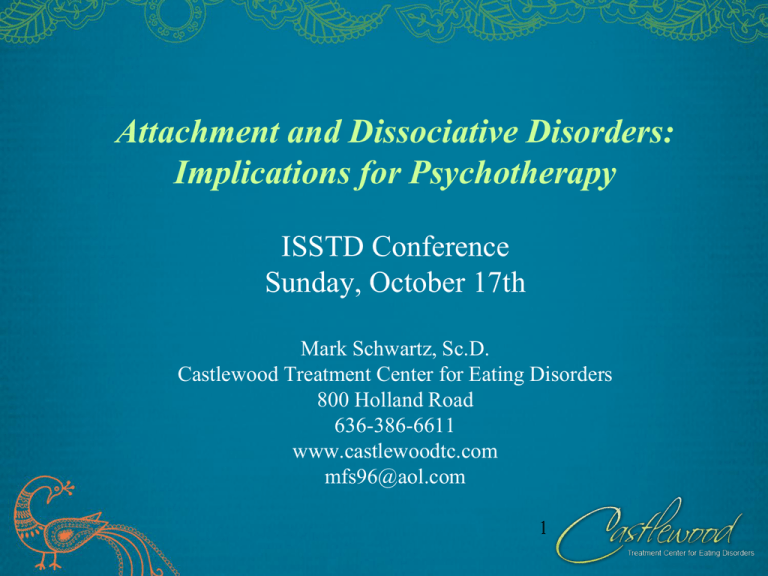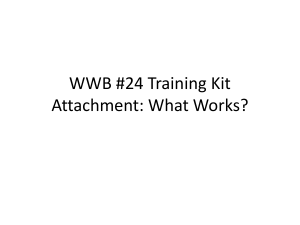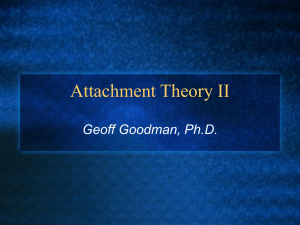Definition - Castlewood Treatment Center
advertisement

Attachment and Dissociative Disorders: Implications for Psychotherapy ISSTD Conference Sunday, October 17th Mark Schwartz, Sc.D. Castlewood Treatment Center for Eating Disorders 800 Holland Road 636-386-6611 www.castlewoodtc.com mfs96@aol.com 1 2 2 3 Inter-Psychic Intimacy (between the couple) vs. Intra-Psychic Intimacy (within the individual) 4 Attachment Trauma The psychologic distress underlying the craving is the result of an inability to metabolize negative emotions utilizing the attachment system (Fosha, 2003; Neborsky, 2003). Successful therapy restores secure attachment which allows for intimate relationships to utilize for self-soothing. Injury to the attachment system is the result of difficulties between the caregiver and child that results in segregated systems of attachment and dissociated self-systems. The result is a variant of narcissism or a false-self personality organization as a means of avoiding the need for attachment. 5 Secure Attachment I L.Alan Stroufe, 2000 • Because their caretakers have been routinely available to them, sensitive to their signals, and response with some degree of reliability (though by no means is perfect care required), these infants develop a confidence that supportive care is available to them. •They expect that when a need arises, help will be available. If they do become threatened or distressed, the caregiver will help them regain equilibrium. •Such confident expectations are precisely what is meant by attachment security. •Secure Attachment (earned) with self. 6 Attachment Process in Eating Disorder and Depression Main, 1990 Deactivation (avoidant) can be maintained through actively diverting attention from attachment issues and distressing childhood memories. A second major type of defensive strategy develops when an individual perceives attachment figures as inconsistently responsive. To maintain the relationship with this type of caregiver, an individual hyperactivates (pre-occupied) the attachment system to constantly monitor the attachment figure and maximize the output of the attachment system. 8 Disorganized Attachment • Drawing close to the other is thus accompanied by the expectation of re-experiencing the anxiety of unpredictable availability, the fear that allowing oneself to ask for and obtain care may mean giving up one’s identity and independence. 9 Ogawa Research • 126 children with disorganized attachment followed until age 19. Prediction of Dissociative Disorder from maternal unavailability and disorganized attachment in the first 24 months of life was more predictive than trauma. Trauma history did not add to the prediction, of dissociation after disorganized attachment. • Specifically maternal Dissociative symptoms, disrupted maternal affective communication, maternal lack of involvement at 12 months, significantly contributed 5 other measures non > 19. 10 Disorganized Attachment The difficulties encountered during the complex process of social adjustment, poor flexibility and resilience in facing life’s painful events, the possibility of building a sense of self that is coherent and integrated, of producing a fluid and coherent narration, ultimately psychopathological suffering itself, seem to point to the attachment pattern as an important aetiopathogenic factor. 11 Dissociation ( Liotta, 2000) • Early dyadic processes lead to a “primary breakdown” or lack of integration of a coherent sense of self, i.e. Unintegrated internal working models. • Disorganized attachment is the initial step in the development trajectory that leaves an individual vulnerable to developing dissociation in response to trauma. 12 “Trauma related to structural dissociation then, is a deficiency in the cohesiveness and flexibility o the personality structure. The lack of cohesion and integration of the personality manifests itself most clearly in the alteration between the vivid re-experiencing of the traumatic event and avoidance of reminders of the traumatic experience.” (van der Hart et al., 2006) 13 “SELF-EMPATHY” - The internalizing (evoking) of the attentive, validating, caring relationship to oneself. This involves helping the client articulate her experience and bring it into her own internal relational context. Target Symptoms For “Earned Secure Attachment” 1. 2. 3. 4. 5. 6. Turning towards other people for self-soothing and intimacy. Establishing a coherent narrative regarding one’s life. Establishing metacognitional thinking in relation to family of origin. Minimize idealization and family loyalties. Establishing clarity with regards to self and self in relation to significant others Resolution of significant losses in one’s life. 15 Adult Attachment 1. Describe your relationship with your parents as a young child (i.e., derogation, relevance violation, loving). 2. 5 adjectives to describe your relationship with mother/father as young child (i.e., idealization, dysfunctional). 3. Your first remembered separation from parent. 4. Ever frightened or worried as a child? 5. Did you tell your parents? 6. Any close relatives or loved one die? 7. How did you respond? 8. Do you think loss has had an affect on your personality? 9. What is your relationship like with your parents now? 16 Refer to Handout on Adult Attachment Protocol Affect and Cognition I Van der Kolk, Brown & van der Hart, 1989 Janet believed that traumatized individuals became phobic about memory because they have failed to develop narratives about their traumata, instead experiencing posttraumatic amnesias and hyperamnesias 18 State of Mind Regarding Attachment COHERENCE: (truthful, succinct, relevant, clean) Steady flow of ideas, intent thoughts, feelings, clear truthful, consistent, plausible responses, completed, but not long. COLLABORATIVE: Speaker appears to value attachment relationships and experiences CONSISTENCY: Descriptions of relationships with parents are supported by specific memories. 19 Metacognitional Metacognition means treatment of one’s mental contents as “objects” on which to reflect, or in other words “thinking about one’s thinking.” Distinct skills contribute to its characterization, such as the ability to reflect on one’s mental states, elaborating a theory of the other’s mind, decentralizing, and the sense of mastery and personal efficacy. 20 Intra-Relational • Relatedness 1. 2. 3. 4. 5. 6. Fostering empathy for dissociated parts of self. Tracking of intra-relational patterns – internal abandonment, ridicule. Understanding survival function of parts of self. Resolution of internal conflicts. Internal witnessing, reduces shame and aloneness. Affect regulation between internal dyads. • Emotional Processing 7. Recognition that different parts of self encompasses different defense strategies, divergent emotions and divergent attachment schemes. • Meta Therapies 8. Recognition that different parts of self encompasses different defense strategies, divergent emotions and divergent attachment schemes. 21 Attachment Therapy for Groups: Concepts and Methods Week 1: Idealization and Family Loyalty Definition: Idealization – the discrepancy between the overall picture or presentation of the parent and the readers inferences regarding actual behavior of the parent. Week 2: Rejection and Neglect Definition: Define rejection and neglect by AAI standards • Reject – child goes to attachment figure with tender feelings and emotions and parents turns away the child’s expression of the emotions “I’ll give you something to cry about…” • Neglect – parent is physically available but inaccessible emotionally/psychologically unavailable Week 3: Loving Behaviors Definition: The attachment figure is dedicated to the development of the child as a person and is emotionally supportive and available. Loving behavior vs. instrumental love vs. non-loving behaviors. Week 4: Involving and role reversal Definition: Define involving and role reversal by AAI standards • Involving – parent uses child attachment system to become the object of the child’s attention • Role reversal – more severe form of involving behavior; the parent uses the child in the role of a spouse or parent, for their own emotional needs 22 Attachment Therapy for Groups: Concepts and Methods Week 5: Caretaking behaviors Involving behavior on the part of our “caretakers” (parents, other attachment figures) can lead us into unhealthy caretaking behaviors in our relationships. Ex. From Alcoholics Anonymous language – Alcoholic as dependent, partner as codependent Definition: Caretaking behaviors deceptively (to self and others): • Keep people in a dependency relationship with you • Keeps you from dealing with your own issues • Require that everyone you care for must conform to your set of rules and norms about their life • Look good and proper on the surface but in reality are a subtle way of manipulating others to keep them under your control • Make you valuable to others who need your assistance, rescuing and help. Week 6: Caretaking vs. Supporting behavior Definition: Review from Week 5 Week 7: Involving Anger Definition: Involving anger is the reason that when a thing happens in relationship, all the past hurt comes in and it feels as if it is a continuation or what always happens. Involving anger sounds like this… “ she was always trying to make me into a little doll that was always doing what she wanted, and she dressed me that way, and for awhile I acted that way, but I’m onto her now and I know what she’s up to and I’m sorry but I am not your little baby doll anymore.” Often longer, but even though it’s a short passage it would score a 6/9 for involving anger on the AAI Week 8: Passivity Partial Definition: The speaker appears unable to prevent sounds or phrases from arising while unable to specify it’s presumed intent or content 23 Therapist > SELF Parts > Protectors > Exiles First Level Second Level Intra-Psychic Intimacy Secure Attachment with Self Attachment Therapy for Groups: Concepts and Methods Week 1: Idealization and Family Loyalty Definition: Idealization – the discrepancy between the overall picture or presentation of the parent and the readers inferences regarding actual behavior of the parent. Purpose: How dismissive clients idealize their family-harmful effects for treatment Intervention: Role played a mini-AAI: Can you give me three adjectives regarding relationship with a parent and then specific supporting memories? (3 glowing adjectives with very little specific memories) When you were upset as a child what would you do? (Not go to parents due to their unloving behaviors) How do you think your overall experiences with your parents have affected your adult personality? (either is hasn’t or they made me stronger) Expressive: 3 chair expressive Narrative concerning struggle with family or parental loyalty; 1st chair-the loving nurturing parent, 2nd chair-the polar opposite behavior of the parent, 3rd client. Client sits any or all chairs and acts out all three parts. 25 Attachment Therapy for Groups: Concepts and Methods Week 2: Rejection and Neglect Definition: Define rejection and neglect by AAI standards • Reject – child goes to attachment figure with tender feelings and emotions and parents turns away the child’s expression of the emotions “I’ll give you something to cry about…” • Neglect – parent is physically available but inaccessible emotionally/psychologically unavailable Intervention: Clients discuss these experiences in their childhood Expressive: Expressive around scene where child was rejected or neglected. Work with parts around this. Have self validate feelings. 26 Attachment Therapy for Groups: Concepts and Methods Week 3: Loving Behaviors Definition: The attachment figure is dedicated to the development of the child as a person and is emotionally supportive and available. Loving behavior vs. instrumental love vs. non-loving behaviors. Intervention: Hakomi exercise: Bring to mind a loving individual in your life that you are willing to share with peers. Get in groups of 3-4. Each person gets 7 minutes to speak about this person with no interruption or feedback. When everyone shares, the last 7 minutes is for the small group to give feedback concerning how each person’s story had an impact on them. Group reconvenes and shares their experience of focusing on loving people and behaviors in their lives. If time permits, write down as many loving behaviors as possible and place them in the rating categories of the AAI loving scale. 27 Attachment Therapy for Groups: Concepts and Methods Week 4: Involving and role reversal Definition: Define involving and role reversal by AAI standards • Involving – parent uses child attachment system to become the object of the child’s attention • Role reversal – more severe form of involving behavior; the parent uses the child in the role of a spouse or parent, for their own emotional needs Intervention: Pre-determined client shares a narrative regarding parental involving behavior. Questions for discussion: • What function do they serve? • Where do these behaviors lead to (present strategies)? • What can you do now (to step away from caretaking behavior)? Expressive: Laura 28 Attachment Therapy for Groups: Concepts and Methods Week 5: Caretaking behaviors Involving behavior on the part of our “caretakers” (parents, other attachment figures) can lead us into unhealthy caretaking behaviors in our relationships. Ex. From Alcoholics Anonymous language – Alcoholic as dependent, partner as codependent Definition: Caretaking behaviors deceptively (to self and others): • Keep people in a dependency relationship with you • Keeps you from dealing with your own issues • Require that everyone you care for must conform to your set of rules and norms about their life • Look good and proper on the surface but in reality are a subtle way of manipulating others to keep them under your control • Make you valuable to others who need your assistance, rescuing and help. Intervention: Make a list of caretaking behaviors from the group and allow discussion as needed. Have clients answer the following (in writing): 1.) What caretaking behaviors do I engage in? 2.) What purpose does this role serve for me personally and/or emotionally? 3.) How does this practice look like healthy behavior? 4.) How is it not healthy behavior for me and what are the consequences? 5.) Where/how did this behavior originate in my life? Expressive: Laura 29 Attachment Therapy for Groups: Concepts and Methods Week 6: Caretaking vs. Supporting behavior Definition: Review from Week 5 Intervention: Caretaking demonstration acted out by staff – three scenarios, and discussion of each. 1. Typical caretaking by clients in group 2. Consequences of using your voice with a caretaker (shows what “strings” are attached) 3. Appropriate resolution of issue between caretaker and the usually dependent person who decided to use their voice. Expressive: Laura 30 Attachment Therapy for Groups: Concepts and Methods Week 7: Involving Anger Definition: Involving anger is the reason that when a thing happens in relationship, all the past hurt comes in and it feels as if it is a continuation or what always happens. Involving anger sounds like this… “ she was always trying to make me into a little doll that was always doing what she wanted, and she dressed me that way, and for awhile I acted that way, but I’m onto her now and I know what she’s up to and I’m sorry but I am not your little baby doll anymore.” Often longer, but even though it’s a short passage it would score a 6/9 for involving anger on the AAI Intervention and Expressive: 1. Revisit – a scene from more recent adult life with an attachment figure (someone you care about, have emotions that could become vulnerable around) where a disproportionate amount of anger arose within you, seen in what you said or what you thought in the moment. 2. Reinterpret (the anger) – break the scene down, view it in slow motion and see what parts are activated and find the origin of the involving anger. Attend to the angry parts as well as the injured parts that the angry one(s) protect. 31 Attachment Therapy for Groups: Concepts and Methods Week 7: cont. Intervention and Expressive: 3. Reevaluate the actions and intentions of the parties in the present scene from this new metacognitive perspective. 4. Release – the anger towards the appropriate targets (e.g. two chair work) 5. Revise – imagine a scene in the near future where involving anger could rear it’s ugly head… 6. Rewrite – the script in coherent and collaborative form and read it aloud. 7. Reintegrate 32 Attachment Therapy for Groups: Concepts and Methods Week 8: Passivity Partial Definition: The speaker appears unable to prevent sounds or phrases from arising while unable to specify it’s presumed intent or content. One of the most surprising finds in early AAI’s was an implied passivity of though processes manifested by: • Overtly vague expressions suggesting an inability to find words or focus on a topic • Failure to complete sentences and lapse into silence or start a new one • Odd words or phrases added to the end of sentences • Wandering to irrelevant topics with no apparent reason • Indeliberate use of child speech or parental style of speech • Pronoun confusion between self and parent in recounting past episodes • These are not dysfluencies and common space fillers like “you know” or “like”… A hand reaches for a book, hesitates, then grabs it is a restart. A hand that reaches for a book and changes direction and grabs a glass is a redirection. These are also common in conversation. But a hand that reaches for a book, stops, then drops limp on the table is analogous to a sentence which is passive. 33 Burdens The concept of “burdens” is brilliant in its widespread application. It sidesteps the need to compare, contrast, count symptoms to diagnose, and postulates instead more of a “no one escapes unscathed” framework. Thus, “burdens” can encompass beliefs, feelings, and energetic residue of events and experiences that overwhelmed the internal and/or external accessible resources of the organism and its attachment environment at the time, thereby creating constraint. 34 Every deep desire, every powerful emotion, gives a trail into the unconscious. Usually there is only one-way traffic: outbound, toward the world of sensation and action. But we can follow the trail to its source by going against the current. With this desire to go against desire, to buck the demands of biological conditioning, the journey of self-realization begins in earnest. Meditation in Action Eknath Easwaran 35 In I.F.S., the more unburdening of these “legacy” and personal burdens, the more space for Self to re-enter. Decreasing compartmentalization leads to an increase in metacognitive capacities and establishment of a coherent, cohesive narrative. 36 Scanning And as I count back not from 7 to 6, you’ll be able to begin to move back safely and comfortably through the years, and from 6 to 5 now, (just continuing back and allowing your mind to begin to scan, much like the tuner on a radio dial, just looking for any strong signal indicating some significant event) and continuing back – from 5 to 4 – back through more and more years, and allowing your mind to continue to scan through the years just looking for any strong signal – and 4 to 3 – and as your mind move s toward some strong signal indicating some significant event, you’ll be able to focus in and talk about where you are and what’s happening. You’ll be able to stay with that event as long as you want and then move on to the next strong signal. And now from 3 to 2 (pause) and 2 (short pause) to 1 – And just allowing your mind to move toward some significant event and as you focus in, just talk about where you are and what you’re aware of. 37 Stuckpoints 1. 2. 3. 4. 5. 6. 7. 8. 9. 10. 11. How am I avoiding remembering? How am I avoiding feelings? How am I avoiding talking about it? How am I minimizing? How am I avoiding focusing on enjoying parts of life? How am I avoiding noticing triggers that cause me to hurt self? How am I avoiding dealing with current life stresses? How am I still protecting those who hurt me? How am I avoiding being close to others? What secrets have I not yet discussed? How am I fighting my therapist and working my program? 38 Schema-Focused DX of Personality Disorders Other Directedness Emphasis on self-denial people pleasing, over emphasis on needs and opinions of others SCHEMAS: self sacrifice approval and recognition seeking Hyper-Criticism & High Expectations In areas of performances & achievement, hypercritical, high expectations for achievement, shames or unloved for inadequate performance. Subjugation & Inhibition Over-Protection & Over-Involvement Over controlled by others restrained emotionally inhibited, rule-bound given little freedom of expression SCHEMAS: Subjugation, over control, punitiveness SCHEMAS: unrelenting standards, failure, error Disconnection & Rejection In area of intimacy & closeness, child is emotionally deprived, socially isolated, made to feel bad, unlovable Over-Indulgence Spoiled, undisciplined Parents over involved in life situations, fostering dependence, discouraging autonomy, enmeshing, worried, over concerned with danger SCHEMAS: Dependence/incompetence , vulnerability to harm and illness enmeshment. Lack of Safety & Stability Mistreated, abused, lied to, betrayed, manipulated, humiliated, abandoned, environment characterized by instability, unpredictability, danger. SCHEMAS: mistrust and abuse SCHEMAS: emotional deprivation, social isolation 39






